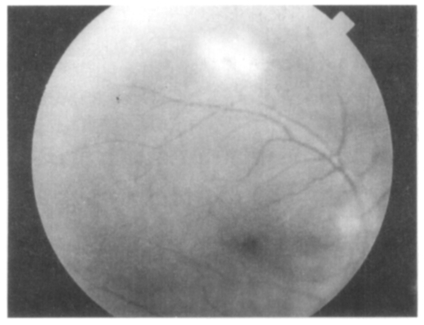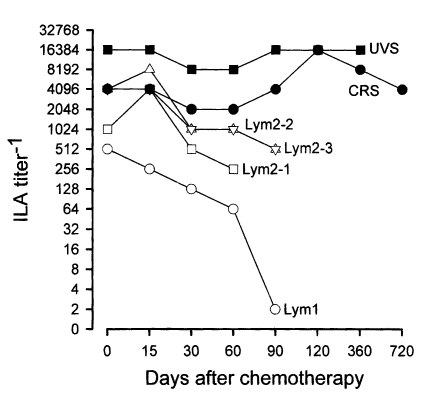Abstract
A toxoplasmic uveitis case was reported on the focus of impairment of pathological findings and serological antibody titers after chemotherapy. A chief complaint of a 60-year-old male was a decreased and blurred vision in his right eye for 2 weeks after experiencing tremendous stress and fatigue. A steroid therapy for 3 weeks was not effective and the retinal lesion became necrotic. Anti-Toxoplasma gondii antibody titer was checked to be a strong positive by both ELISA and indirect latex agglutination assay (ILA). He was treated with Fansidar F for 8 weeks. His vision improved as the necrotic lesion healed by scarring, but the antibody titers still remained very high without any signs of negative conversion. It is suggested to be a recurrent case of the past asymptomatic infection by presumed immune suppression caused by excessive stress.
-
Key words: Toxoplasma gondii, uveitis, recurrence, chemotherapy, antibody titer
The protozoan parasite
Toxoplasma gondii is an important cause of ocular diseases both in immunosuppressed and immunocompetent individuals (
Tirard et al., 1991;
Choi et al., 1997).
Toxoplasma gondii can reach the eye through the bloodstream or be transmitted from the brain via the optic nerve (
Roberts and McLeod, 1999). Active ocular toxoplasmosis consists of well-defined foci of coagulative necrosis of the retina or diffuse inflammation in the retina and the choroid. We described a toxoplasmic uveitis case focused on the difference in the retinal lesion and antibody titers after chemotherapy.
On December 15, 1997, a 60-year-old man visited out-patient clinic at the Department of Ophthalmology, Catholic University of Korea, College of Medicine, due to a decreased and blurred vision in his right eye which persisted for 2 weeks with slight muscle pain. He had no other previous problems with his general health, but he had been treated with oral antihypertensive drugs for 5 years. With a slit-lamp examination, mild inflammatory reaction was detected in the anterior chamber and vitreous body. Through an ophthalmoscopy, one optic disk-sized whitish retinal infiltration was observed in the superior temporal vascular area. One percent of prednisolone acetate (O-LON) solution was applied topically for 10 days (4 times/day). However, retinal infiltration continued to progress and sheath perivascularly on ophthalmoscopy, and hypofluorescent retinal area was detected on a fluorescein angiography. Retinal necrosis was suspected, thus 40 mg of prednisolone (H-LON) was orally administered 3 times a day. Two weeks later, the fundus examination of the right eye showed aggravated inflammation and retinal necrosis as shown in
Fig. 1. Oral administration of prednisolone was terminated.
Serological tests for
T. gondii were performed by IgG-ELISA and ILA, both of which resulted in strong positives, 1.02 for ELISA with a cut-off value of 0.25 and 1:16,384 for ILA with a cut-off value of 1:32. An oral combination therapy with Fansidar F (25 mg pyrimethamine plus 500 mg sulfonamide, Hoffmann-La Roche, Basel, Switzerland) and prednisolone was carried out for 8 weeks. Five weeks after chemotherapy, inflammatory cells could not be found in the anterior chamber, but there were still one or two positive reactions of inflammatory cells in the vitreous body. The whitish retinal necrotic lesion around the superior temporal vascular area disappeared and the pigmental change in the lesion was observed with the fundus examination. On July 8, 1998, the corrected visual acuity of the right eye improved to 0.63, and there was no inflammatory vitreous opacity. Only clear-cut margin of whitish retinal lesion was observed in the superior temporal vascular area of the right eye. However, antibody titers by ELISA and ILA were still in a high range until now (
Fig. 2), dotted rectangle line (labeled by UVS). This is compatible with another chorioretinitis case (dotted circle, labeled by CRS,
Choi et al., 1997) as described as limitations of relation between serological examination and the ocular pathology (
Holliman et al., 1991), whereas those of lymphadenitis cases appeared to be decreased rapidly in antibody titers (Lym1 of
Kim et al., 1993 and Lym2-1, 2-2, and 2-3 of
Choi et al., 1997) after chemotherapy.
The patient has enjoyed eating rare-cooked steaks during his frequent visits to many European nations since his young age as an economic specialist. Most European nations are known to have high toxoplasmosis incidences epidemiologically where the meat harboring tissue cysts is the major source of infection (
Dubey and Beattie, 1988). He may have been infected in the past without any recognized symptoms, but have become symptomatic by the reactivation of chronic infection presumed reduction in immunity (
Holland et al., 1988) caused by extensive stress and excess fatigue to cope with the national economic crisis and IMF situation in Korea since the end of 1997.
Toxoplasmic retinochoroiditis is the major cause of visual impairment in the U.S.A. and the European nations, where it accounts for 30-50% of all cases of the posterior uveitis (
McCannel et al., 1996). However, detection of retinal diseases caused by
T. gondii are limited in Korea. There is a difference in toxoplasmic environment such as the low prevalence rate and titers of antibody (
Choi et al., 1992) resulted from different food-eating habit and pet-loving fashion in Korea. Additionally, ocular toxoplasmosis has been paid less attention by clinicians in the fields of ophthalmologic and infectious diseases. However, as the living pattern changes gradually, the probability of
T. gondii infection is expected to increase. We suggest that the patients of ocular inflammation should be checked serologically in order to diagnose toxoplasmosis or to rule out the possibility of infection prior to a corticosteroid treatment.
Notes
-
This study was supported by the Sengeui Research Grant of Catholic Medical Center, 1998.
References
- 1. Choi WY, Nam HW, Kwak NH, et al. Foodborne outbreaks of human toxoplasmosis. J Inf Dis 1997;175:1280-1282.
- 2. Choi WY, Nam HW, Youn JH, et al. Detection of antibodies in serum and cerebrospinal fluid to Toxoplasma gondii by indirect latex agglutination test and enzyme-linked immunosorbent assay. Korean J Parasitol 1992;30:83-90.
- 3. Dubey JP, Beattie CP. Toxoplasmosis of animals and man. 1988, Boca Raton, FL, USA. CRC Press.
- 4. Holland GN, Engstrom RE, Glasgow BJ, et al. Ocular toxoplasmosis in patients with the acquired immunodeficiency syndrome. Am J Ophthalmol 1988;57:1-17.
- 5. Holliman RE, Stevens PJ, Duffy KT, Johnson JD. Serological investigation of ocular toxoplasmosis. Br J Ophthalmol 1991;75:353-356.
- 6. Kim SE, Kim YR, Shin WS, et al. A case of toxoplasmosis infected in the laboratory. Infection 1993;25:63-69. (in Korean).
- 7. McCannel C, Holland GN, Helm CJ, Cornell PJ, Winston JV, Rimmer TG. Causes of uveitis in the general practice of ophthalmology. Am J Ophthalmol 1996;121:35-46.
- 8. Roberts F, McLeod R. Pathogenesis of toxoplasmic retinochoroiditis. Parasitol Today 1999;15:51-57.
- 9. Tirard V, Niel G, Rosenheim M, et al. Diagnosis of toxoplasmosis in patients with AIDS by isolation of the parasite from the blood. New Engl J Med 1991;324:634.
Fig. 1The fundus of the patient before chemotherapy showing diffuse lesion of inflammation.

Fig. 2Changes in ILA titers after chemotherapy of ocular toxoplasmosis with respect to toxoplasmic lymphadenites. UVS, uveitis in this case; CRS, chorioretinitis, Lym1, Lym2-1, Lym2-2, and Lym2-3, lymphadenitis, respectively.

Citations
Citations to this article as recorded by

- Seroprevalence of Toxoplasma gondii assayed using Rapid Diagnostic Tests among Residents in Three Counties Adjacent to The Demilitarized Zone, Korea
Jeehi Jung, Jinyoung Lee, Yoon Kyung Chang, Seong Kyu Ahn, Seo Hye Park, Sung-Jong Hong, Jihoo Lee, Chom-Kyu Chong, Hye-Jin Ahn, Ho-Woo Nam, Tong-Soo Kim, Dongjae Kim
The Korean Journal of Parasitology.2021; 59(1): 9. CrossRef - Clusters of Toxoplasmosis in Ganghwa-gun, Cheorwon-gun, and Goseong-gun, Korea
Jihye Yu, Woojin Kim, Yoon Kyung Chang, Tong-Soo Kim, Sung-Jong Hong, Hye-Jin Ahn, Ho-Woo Nam, Dongjae Kim
The Korean Journal of Parasitology.2021; 59(3): 251. CrossRef - Clusters of Toxoplasmosis in Gyodong-Myeon and Samsan-Myeon, Ganghwa-Gun, Korea
Woojin Kim, Yoon Kyung Chang, Tong-Soo Kim, Sung-Jong Hong, Hye-Jin Ahn, Ho-Woo Nam, Dongjae Kim
The Korean Journal of Parasitology.2020; 58(5): 493. CrossRef - Multilayered rule-based expert system for diagnosing uveitis
A.M. Mutawa, Mariam A. Alzuwawi
Artificial Intelligence in Medicine.2019; 99: 101691. CrossRef - Seroprevalence of Toxoplasmosis with ELISA and Rapid Diagnostic Test among Residents in Gyodong-do, Inchon city, Korea: A Four-Year Follow-up
Yeong Hoon Kim, Ji hoo Lee, Seong kyu Ahn, Tong-Soo Kim, Sung-Jong Hong, Chom-Kyu Chong, Hye-Jin Ahn, Ho-Woo Nam
The Korean Journal of Parasitology.2017; 55(3): 247. CrossRef - Seroprevalence of Toxoplasmosis Detected by RDT in Residents near the DMZ (demilitarized zone) of Cheorwon-gun, Gangwon-do, Korea
Yeong Hoon Kim, Jihoo Lee, Young-Eun Kim, Seongkyu Ahn, Tong-Soo Kim, Sung-Jong Hong, Chom-Kyu Chong, Hye-Jin Ahn, Ho-Woo Nam
The Korean Journal of Parasitology.2017; 55(4): 385. CrossRef - A comparative study between excretory/secretory and autoclaved vaccines against RH strain of Toxoplasma gondii in murine models
Hayam Mohamed Ezz Eldin, Hanan Hussein Kamel, Abeer Fathy Badawy, Lobna Sadek Shash
Journal of Parasitic Diseases.2015; 39(3): 526. CrossRef - High Expression of Water-Soluble Recombinant Antigenic Domains ofToxoplasma gondii Secretory Organelles
Zhaoshou Yang, Hye-Jin Ahn, Ho-Woo Nam
The Korean Journal of Parasitology.2014; 52(4): 367. CrossRef - Clinical Update on Parasitic Diseases
Min Seo
Korean Journal of Medicine.2013; 85(5): 469. CrossRef - A Surge in the Seroprevalence of Toxoplasmosis among the Residents of Islands in Gangwha-gun, Incheon, Korea
Zhaoshou Yang, Pyo Yun Cho, Seong Kyu Ahn, Hye-Jin Ahn, Tong-Soo Kim, Chom-Kyu Chong, Sung-Jong Hong, Seok Ho Cha, Ho-Woo Nam
The Korean Journal of Parasitology.2012; 50(3): 191. CrossRef - Detection of Ocular Toxoplasma gondii Infection in Chronic Irregular Recurrent Uveitis by PCR
Sang-Eun Lee, Sung-Hee Hong, Seong-Ho Lee, Young-Il Jeong, Su Jin Lim, Oh Woong Kwon, Sun Hyun Kim, Young Sung You, Shin-Hyeong Cho, Won-Ja Lee
The Korean Journal of Parasitology.2012; 50(3): 229. CrossRef - Clinical Features of Ocular Toxoplasmosis in Korean Patients
Young-Hoon Park, Jae-Hyung Han, Ho-Woo Nam
The Korean Journal of Parasitology.2011; 49(2): 167. CrossRef - Laboratory passage and characterization of an isolate of Toxoplasma gondii from an ocular patient in Korea
Jong-Yil Chai, Aifen Lin, Eun-Hee Shin, Myoung-Don Oh, Eun-Taek Han, Ho-Woo Nam, Soon-Hyung Lee
The Korean Journal of Parasitology.2003; 41(3): 147. CrossRef - Molecular cloning of ribosomal P protein in Toxoplasma gondii and the availability to detect antibody against recombinant protein in toxoplasmosis patients
Hye-Jin Ahn, Sera Kim, Ho-Woo Nam
The Korean Journal of Parasitology.2003; 41(2): 89. CrossRef - Protease Activity and Host Cell Binding of the 42-kDa Rhoptry Protein from Toxoplasma gondii after Secretion
Hye-Jin Ahn, Kyoung-Ju Song, Eui-Sun Son, Jong-Chul Shin, Ho-Woo Nam
Biochemical and Biophysical Research Communications.2001; 287(3): 630. CrossRef - Detection and characterization of excretory/secretory proteins from Toxoplasma gondii by monoclonal antibodies
Eui-Sun Son, Ho-Woo Nam
The Korean Journal of Parasitology.2001; 39(1): 49. CrossRef



